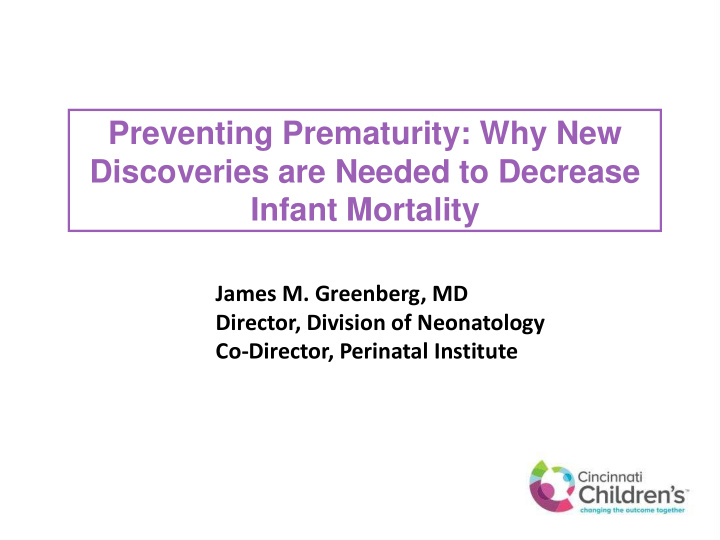



Preventing Prematurity: Why New Discoveries are Needed to Decrease Infant Mortality James M. Greenberg, MD Director, Division of Neonatology Co-Director, Perinatal Institute
Preventing Prematurity - A Critical Unmet Need In Child Health • Preterm birth (birth at less than 37 weeks of pregnancy) is a major public health concern worldwide. • In Ohio, 10% of births occur before term. – preterm birth is the single largest cause of infant deaths. • No generally effective interventions currently exist. Worldwide Disability Adjusted Life Years (millions)
What Has Been Tried to Prevent Prematurity? • More frequent visits for prenatal care • Elimination of Early Elective Deliveries • Bed rest • Better management of fertility treatment • Risk reduction – such as smoking cessation • Progesterone • Antibiotic treatment • Cerclage (alone or with Progesterone)
What determines the timing of birth? Viability Optimal Time Ex Utero for Birth Conception TIME Understanding preterm birth requires understanding the interplay between genetics, biology, environment, and key social determinants of health
Many Factors Lead to Preterm Birth SES Social Determinants Stress Infection, • Uterine Inflammation contractions Racism • Dilation of Genetics cervix/LUS Health Behaviors • ROM Health Status Geography Nutrition
What possibilities would there be if genes contributing to preterm labor were identified? • Prenatal identification of women at risk to allow close monitoring • Identification of new therapeutic targets for treatment of active preterm labor • Early detection of preterm labor before overtly active for early treatment institution • Possible prophylactic therapy for all women (similar to folic acid for neural tube defects) – selenium as an example.
Using Human Genetics to Unravel the Biology of Birth Timing and Prematurity Hypotheses Genetic variation in humans contributes to the risk of preterm birth Identification of genes that predispose to preterm birth will provide new insight into normal mechanisms of control of parturition
Why Consider Genetics? • Sisters of women with preterm infants more likely to have preterm infants in studies from Scotland, Denmark and US • Increased risk of delivering preterm infant if mother preterm • 4-fold increase in recurrent preterm birth in African American mothers after adjustment for other risk factors
The first identification of maternal preterm birth genes revealed by Dr. Lou Muglia and colleagues at Cincinnati Children’s Gestational Duration Preterm Birth Genotypes of 44,000 women in collaboration with 23andMe, Inc. Zhang et al., NEJM 2017
New Targets for Intervention in Prematurity! • Five Novel Genes: EBF1, WNT4, AGTR2, ADCY5, EEFSEC • Selenium metabolism • Does selenium deficiency predict preterm birth?
March of Dimes Cross-Ohio Collaboration
Connecting Genetics with Social Determinants Evidence Real People New Knowledge • Collective impact • >28 partners • Community engagement • Service
Many Factors Lead to Preterm Birth SES Social Determinants Stress Infection, • Uterine Inflammation contractions Racism • Dilation of Genetics cervix/LUS Health Behaviors • ROM Health Status Geography Nutrition
Summary Concepts • Prevention of preterm birth requires a comprehensive, integrated approach incorporating deep understanding of the social determinants of health AND the biological determinants of human birth • The internationally recognized leaders in preterm birth research are right here in Ohio!
Recommend
More recommend